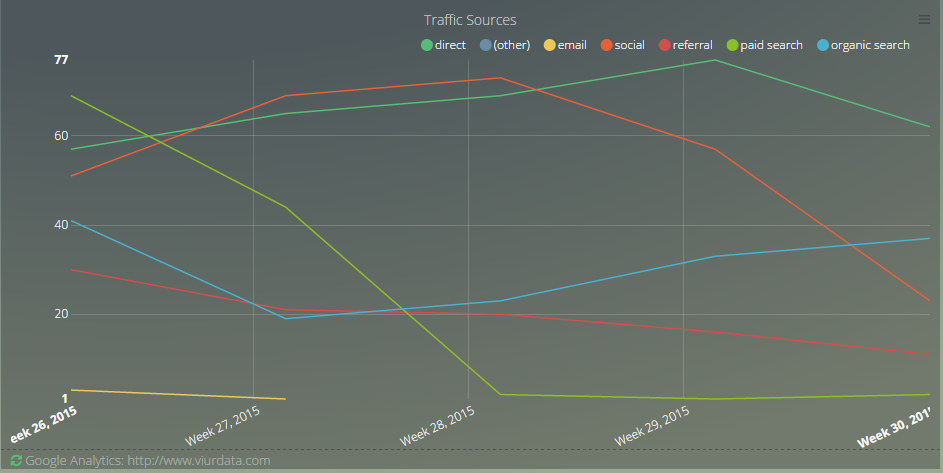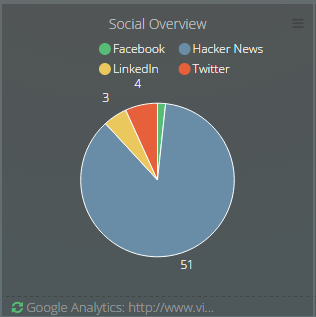In this small article I’ll cover some metrics that can give additional insights on your marketing efforts and how do you get to them on Google Analytics. Plus some example charts I use in Viur for visualizing them.
Traffic Sources
Traffic sources are the channels that you have open to the web. You want to keep them effective and constantly bringing new people to your site. You should pay particular attention to the organic ones (all but the paid search) and keep them growing week after week. You can achieve this by creating new (quality!) content and distributing it in a blog post, newsletter, and social media. If people love your content they’ll share.
also, if you are using paid advertising on search engines you can see how it’s going comparing against the other non-paid channels.
where to find on G.A.: Aquisition > Overview

Social Presence
This one is a bit of a subset of the Traffic Sources and allows you to see what social networks bring you more traffic. You should not be preoccupied with having an equal share on all networks since your target market might prefer one over another. People use more Facebook for personal matters and Linkedin professionally, so for example, a B2C product might work better than a B2B on Facebook. You should focus on creating or adapting your content to each social network: hashtags might work great on Twitter, pictures on Facebook and infographics on Linkedin. Find what content works best for you in each channel.
where to find on G.A.: Aquisition> Social> Overview

Device Type
At first glance, it might not strike as an important metric, but it’s absolutely crucial if you want to split the effort of improving the site usability for a particular device type. As you might know, since April 2015 Google has rolled out a new ranking algorithm that privileges mobile friendly sites. That means that if your site isn’t adapted to smaller screen resolutions, it will be penalized in terms of page rank. If most of your users come from a mobile device you should have a good mobile site and not just one that google ranks as good.
where to find on G.A.: Audience> Mobile> Overview

Languages
If your site doesn’t have an English page it should since it’s the global language of business. But if you know from where your visitors come from, you might create new business opportunities by translating your website to your visitor's native language. Furthermore, by having your website translated in other languages it will perform better in search queries that people will do in their native tongue. There are services like Unbabel that can do that at affordable prices.
where to find on G.A.: Audience> Geo> Language

Browsers
Not all browsers render pages the same way (Internet Explorer, I’m looking at you!). Developers have the tendency to not test every browser, so if you’re having a lot of hits from a particular browser, it’s good to know if your page works on that one, or if people are abandoning your site just because the experience is poor.
where to find on G.A.: Audience> Technology> Browser & OS

There are many more metrics that allow you to have a better perspective on your marketing efforts, and I’ll write about them in a future article. All these metrics are quick and easy to build in Viur or in the Google Analytics page, so there is no excuse for not putting them in practice.